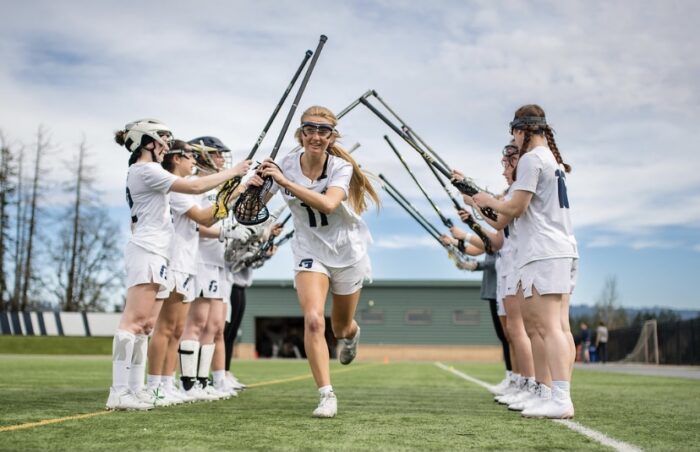 For as long as she can remember, Lyla has had a love of sports running through her veins. With a naturally competitive and determined spirit, the 21-year-old of Tacoma, Wash., participated in athletics throughout her high school and college years.
For as long as she can remember, Lyla has had a love of sports running through her veins. With a naturally competitive and determined spirit, the 21-year-old of Tacoma, Wash., participated in athletics throughout her high school and college years.
“Lacrosse was everything to me at this point in my life,” she said.
Lyla vividly recalls the moment when she learned that her ability to play could soon change.
During the summer before her senior year of college, Lyla’s grandmother was cutting her hair and noticed something different about Lyla’s spine.
Originally diagnosed in the eighth grade with adolescent idiopathic scoliosis (AIS) during a routine school-based scoliosis screening, Lyla’s family was already familiar with the abnormal curvature of her spine, which at the time measured at 42-degrees and did not require surgical intervention, but now several years later, the AIS seemed to be getting worse.
About 2% of children have idiopathic scoliosis, and in most cases, only about 2 in 1,000 children have a curve large enough to treat. Surgery is typically not performed until the curve is greater than 50 degrees. Caring for AIS requires interdisciplinary expertise in various specialties from neurosciences, pulmonary, sleep medicine, adolescent medicine, rehabilitation medicine and pain medicine teams, among others.
“That is when my mom made the appointment with Seattle Children’s Orthopedics and Sports Medicine Program, to have my spine looked at once more,” Lyla explained. “I thought nothing of the appointment and assumed it was just a routine check in.”

The director of spine surgery at Seattle Children’s, Dr. Jennifer Bauer, who treats all aspects of the spine for patients of all ages, including both common and rare complex problems, reviewed the X-rays and confirmed that Lyla’s spine had in fact progressed past the 50-degree mark. The recommended treatment for her now 60-degree curved spine was surgery.
“My heart sank,” Lyla said. “Lacrosse season started in January, and it was August. I had never wanted [my scoliosis] to disrupt my life and here I was, heading into my senior collegiate season being told I needed spine surgery, which does not have the easiest nor quickest recovery. Right then and there, we did the math. I needed the surgery as soon as possible to be able to play my senior season.”
Lyla’s spine team understood the importance of her senior lacrosse season and rearranged the schedule to find a spot for her surgery just one week later. They also worked with Lyla to accelerate her post-operative recovery to make sure she could get back to full speed in time for the season. Seattle Children’s pediatric orthopedic experts are the most experienced in the region and perform well over 150 spine surgeries a year. Lyla knew she was in good hands.
“Our surgeons are part of national and international research and clinical trials on the spine,” explained Dr. Bauer. “Because we’re on the cutting edge of pediatric spine surgery at Seattle Children’s, we offer AIS patients options that are not commonly found elsewhere. For Lyla, we were able to fuse her two spine levels shorter than the textbooks would normally direct us to, to save her as much motion for her sports as possible.”
“AIS is the most common type of scoliosis affecting kids ages 10 to 18, but there are many intricacies and aspects to doing a good AIS surgery,” added Dr. Bauer. “Kids, older teens, and even young adults will get the best diagnosis and treatment options from a high-volume team that works only with pediatric patients, all day every day.”

To Lyla’s surprise, the surgery was actually one of the easiest parts of the experience, and now with two cobalt-chrome rods and 17 titanium screws securing her spine in position, Lyla even discovered that she was nearly two and half inches taller!
“That was cool,” she said. “My mom showed me the X-rays and I cried tears of joy.”
Over the next few months, Lyla’s new goal was to heal and play lacrosse in her team’s upcoming season. She meticulously followed the plan provided by her doctors, knowing it could be the difference in being on the field or watching from the bench.
By January, Lyla passed her mandatory fitness tests and started in all 19 games. She later graduated from George Fox University and got married. Today, she is the coach of a local high school lacrosse team and still doing what she loves.

“By the grace of God and Dr. Bauer’s expertise and flexibility, I sit in my office today with perfect posture and no pain,” Lyla said. “At every turn of my experience at Seattle Childrens, I was met with the highest quality care. I feel nothing but gratitude.”
